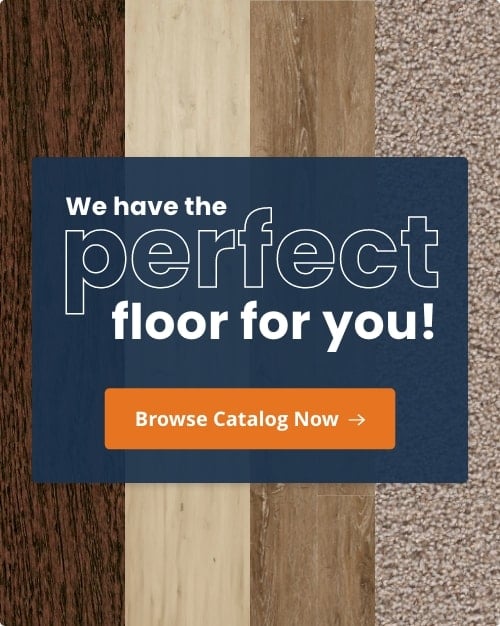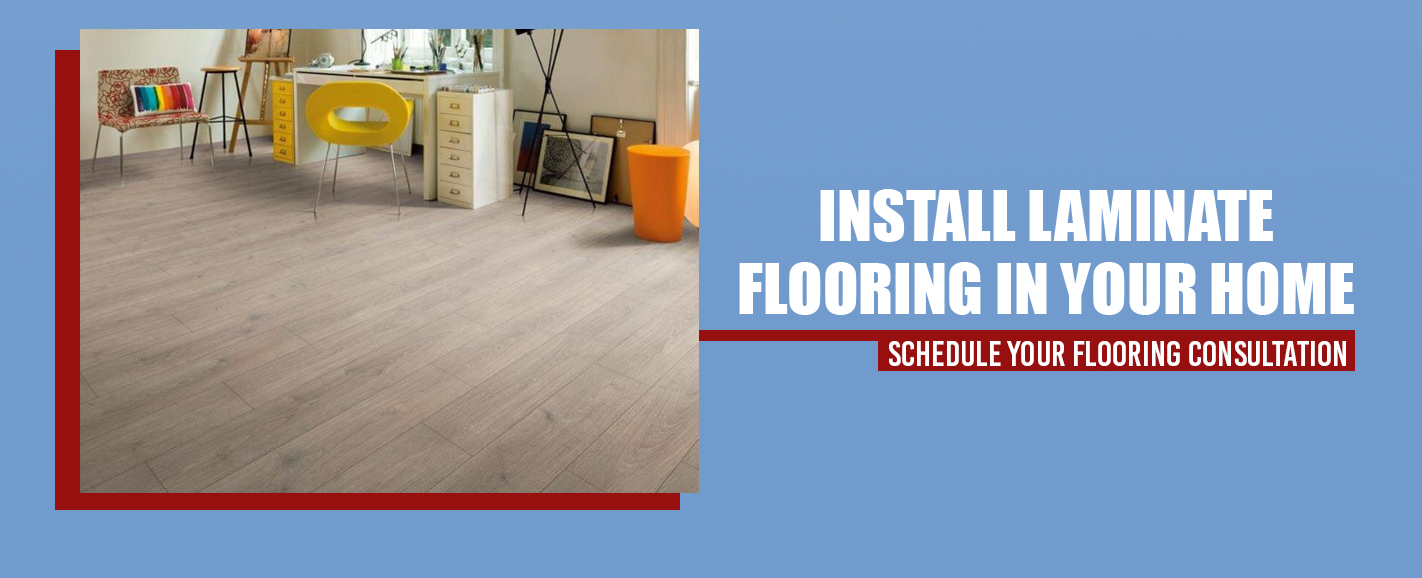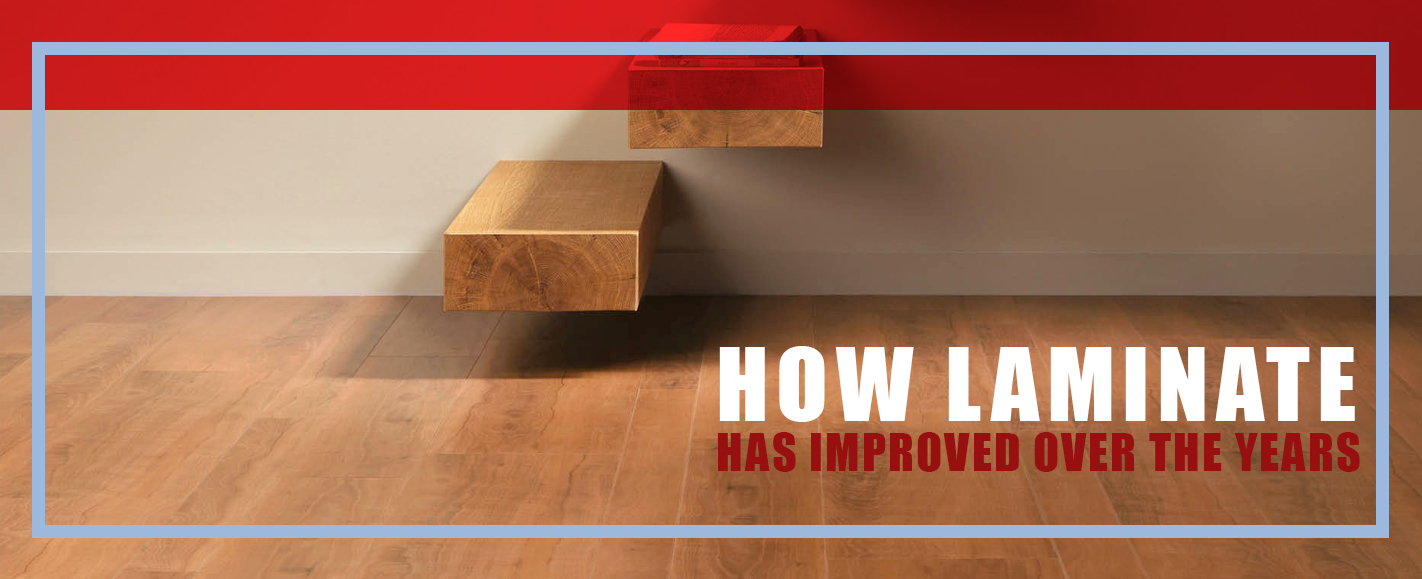

Are you someone who’s always heard phrases like, “Hardwood floors are the only way to go?” Maybe in your book, if it isn’t hardwood, then it’s somehow cheap or lesser. While it’s true that hardwood floors do bring a touch of elegance to any space they touch, they’re far from the only type of flooring out there that’s worth installing in your home.
Tile, for example, is one possible solution. Vinyl is another possibility, and laminate flooring is yet another excellent option for your home flooring solution.
We know — you may be raising an eyebrow at the idea of laminate being an ideal material to use for your floors. These days, though, modern laminate flooring is a highly reliable, durable and attractive flooring that’s an effective choice in many different situations — maybe even yours.
To help set the record straight, we’re here to provide you with the facts. We’ll talk about the evolution of laminate flooring and how it has arrived at where it is today, as well as all the reasons laminate can benefit you and your home.
Ready? Then let’s get started.
What Is Laminate Flooring?
Laminate flooring is made up of multiple layers, all placed together and designed so that they look like a very good imitation of a genuine wood floor. It just comes at a fraction of the cost and is much less susceptible to things like water damage and other types of harm.
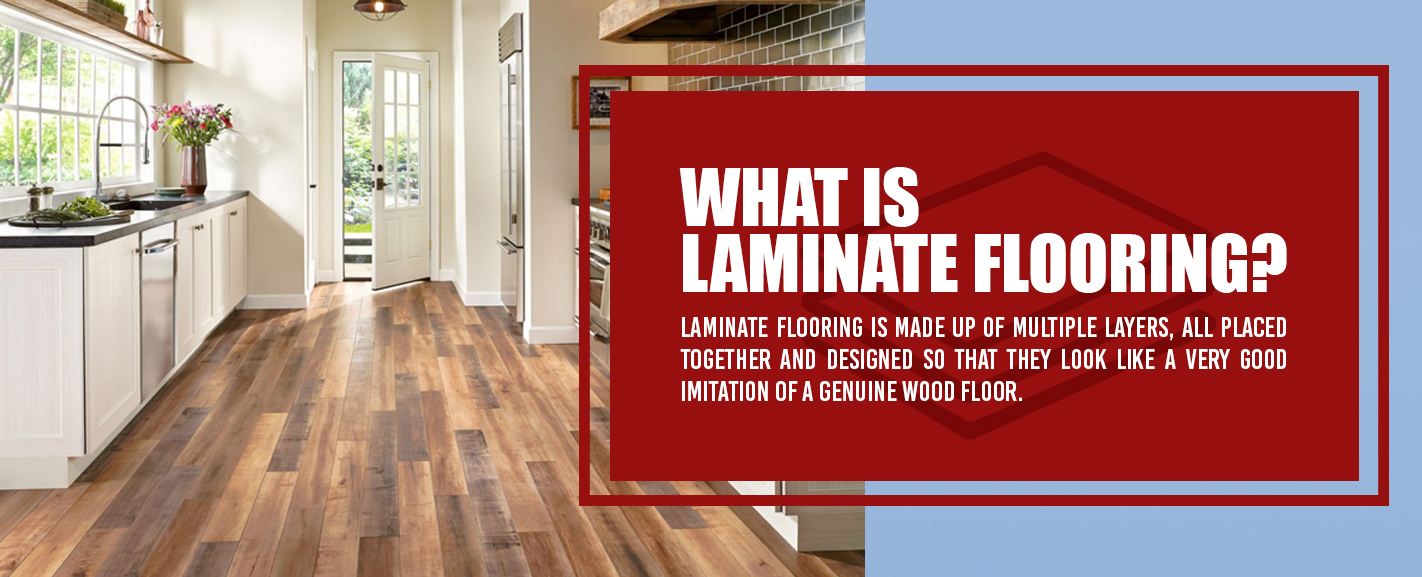

From the bottom to the top, laminate floors start with a backing layer. This initial layer of construction serves the primary purpose of keeping moisture out and preventing water from seeping in and ruining the floor. Think of this like an extra layer of insulation.
Additionally, laminate floors will have a fiberboard core that provides most of the floor’s structure, stability and impact resistance. This is what we would consider to be the real “floor.” The rest of the layers surrounding it are for additional security and decoration. The core layer lies on top of a balancing layer and is the center part of the flooring. The core layer is made up of HDF (high Density Fiber board), MDF (Medium Density Fiber board), and consumer recycled wood fibers and chips.
Next comes the decorative layer. This layer serves to give the flooring the distinctive “wood” appearance. Because this layer is responsible for creating most of the look you’re going for, it is a highly decorative element, styled and textured in such a way as to imitate the appearance of natural wood. It can come in a variety of shades or wood grain styles, and in some cases, it is difficult to tell it apart from real wood when judging by appearance alone.
The top or wear layer is a decorative layer that is coated with an aluminum oxide, which helps to protect the floor and give it shine, scratch, and UV protection.
Wood isn’t the only thing this middle layer can imitate, either. It can also be styled to resemble stone, metal or other materials. Wood is generally the most popular style, though, and is the one you’re likely to see the most often.
The individual laminate floorboards neatly lock together, their edges flush with one another in such a way that eliminates the need for nails, glues or any other type of traditional fastening agent. Additionally, these laminate flooring planks “float” above the subfloor, meaning they’re not laid directly over the top of it. Instead, there’s a small air cushion there that gives the floorboards room to expand and contract with the fluctuating humidity levels in your house.
The History of Laminate Flooring
Laminate flooring history is a story that starts in the 1970s, when the first early laminate floors began arriving on the market. While these floorings bore some resemblance to what we recognize today as laminate flooring, they were ultimately a far lower quality. Many of the kinks had yet to be worked out of the design, and as a result, not many people jumped on board with this new product.
These early laminate floorings are likely responsible for creating the stereotype that laminate flooring is far inferior to traditional wood flooring. At the time, this was certainly true. However, recognizing the potential market for imitation wood floors that could be purchased for a fraction of the cost of real wood floors, manufacturers persisted in trying to perfect their designs.
The first modern laminate flooring hit the markets in 1984, as the result of efforts on the part of Perstorp AB Holdings, a dominating company within the chemical industry. This company developed a product known as Pergo, which essentially took the same formula for decorative laminate that was commonly used on countertops at the time and applied it to flooring.
These Pergo floors were a hit in Europe first, where they quickly became the biggest thing in flooring trends since cushioned vinyl’s popularity in the 1960s. While popular in many settings and locations, the laminate became an especially common choice in household kitchens.
Pergo flooring didn’t truly take off in America until the mid-1990s, where it quickly began attracting a similar amount of enthusiasm and attention. People started rushing to install this style of flooring because of the way it let them enjoy all the beauty and sophistication of a wood floor at a far more affordable cost.
Laminate floors during this stage hardly ever passed for real wood. While the look was certainly there, almost no one would ever mistake this layered flooring as the real deal. This was largely thanks to a highly-plastic looking finish on top.
Modern Developments in Laminate Flooring
Many more advancements have been made in the world of laminate flooring since the 1990s. Nowadays, laminate flooring is nearly impossible to tell apart from the material it’s meant to be mimicking. Whether that material is wood, stone, metal or brick, the imitation is so good that visitors to your house will likely never know the difference — allowing it to be your little secret.
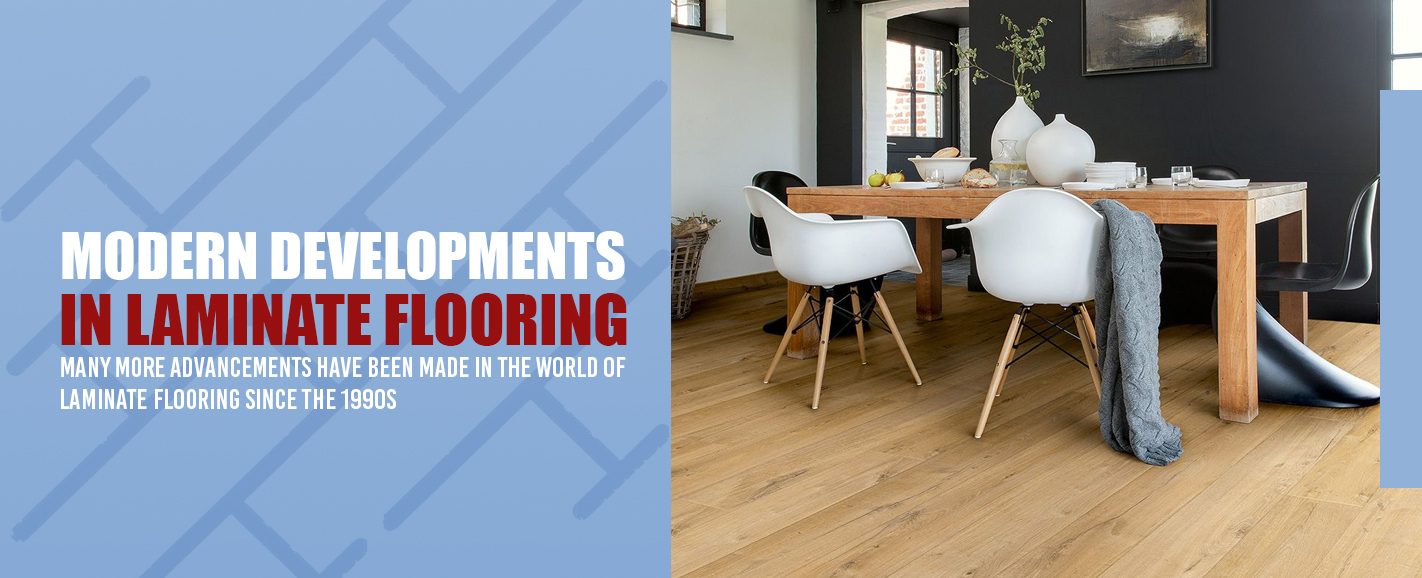

This new level of authenticity is achieved through distressed finishes, grooves, texturing and beveling, all of which create the impression that the artificial laminate is, in fact, a piece of wood. A natural wood grain look is built directly into the laminate itself so that it not only looks real, but it even feels real under your feet.
Because of advances in technology, laminate flooring is also now more practical in terms of the actual layering process than it was in the past. The fiberboard core, which makes up the majority of the critical middle layer, is now far more advanced than it used to be, and it has become more durable, stable and resistant to damage. The bottom layer as well, so crucial in absorbing both noise and minor bumps and pocks in the sub-flooring, is now better equipped than ever to do its job.
One of the most recent developments to make real waves in the laminate flooring business is an improved level of water-resistance. Laminate floorboards have also recently become more impact-resistant, allowing them to hold up against more regular wear-and-tear as well as blunt impacts to last longer and look great while doing it.
Schedule Your In-Home Consultation
Why Is Laminate Flooring the Right Choice for You?
Ultimately, you are the only person who can know which kind of flooring is the right one for your unique situation. You likely have a list of requirements that you’ll compare against every type of flooring out there, and this will help you arrive at the best decision possible for you.
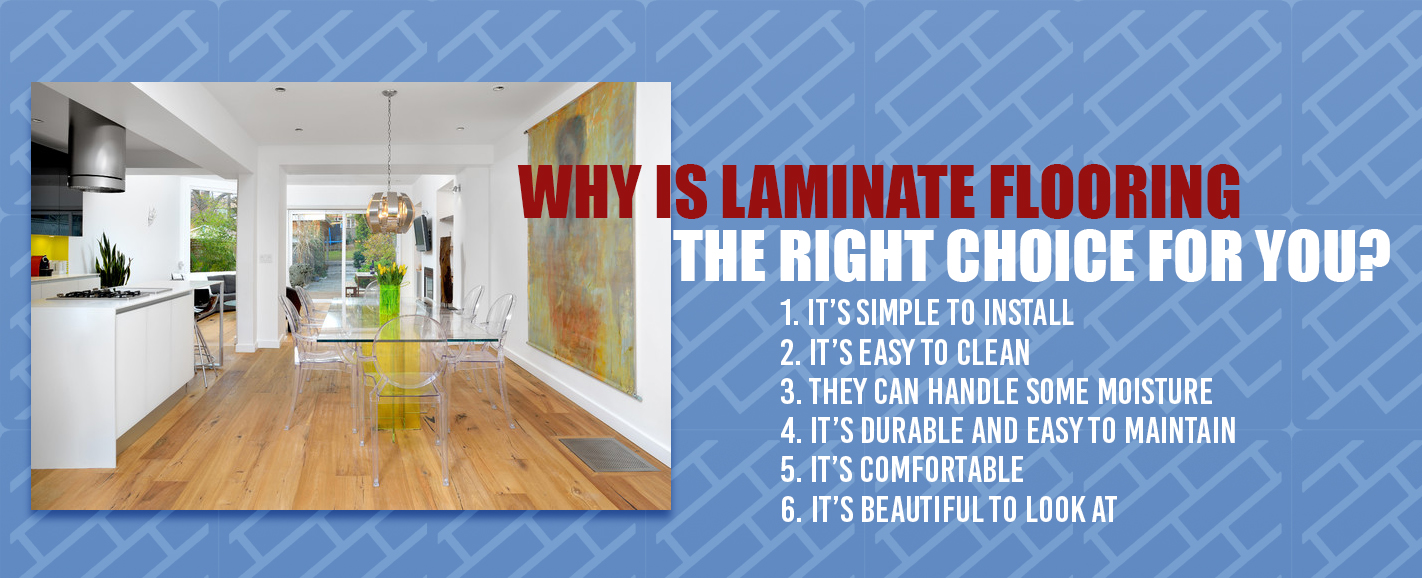

If you’re considering laminate flooring, you should have a clear picture of all the benefits and advantages this handy type of flooring brings:
1. It’s Simple to Install
With many flooring types, installing them is an enormous project that requires you to set aside that room for multiple days while the flooring is laid. It might also require expensive professional contractors as well as all sorts of binding agents like nails, glues and coatings to hold the floor together. All of these elements take both time and money, and, they can be a real inconvenience to your daily life.
Laminate flooring, on the other hand, is both quick and easy to install. No binding or fastening agent is required — the different pieces simply click together like puzzle pieces by way of a simple locking technology. If you can put together a jigsaw puzzle, then you can put together a laminate floor. The whole process goes extremely quickly as well. You can easily install 300 square feet in as little as one weekend’s worth of work.
2. It’s Easy to Clean
Hardwood floors can sometimes be difficult to clean, as excessive water can be damaging to the delicate finish. Waxing is sometimes needed, and many common cleaning products should not even come into contact with a true wood floor.
Laminate offers easy cleaning. Grab a broom or a vacuum to clean up loose dirt and hair. For a deeper clean, try mopping with a damp mop. A steam mop is not recommended. You won’t ever need to wax these floors, which cuts down on both time and money.
3. They Can Handle Some Moisture
For many types of flooring, moisture is a huge no-no, as it can seep into the floors and cause all kinds of rippling and damage. Laminate flooring is sturdy, however, and it has built-in defenses against low levels of moisture. This type of moisture, known as topical moisture, is common in spaces like bathrooms and kitchens, and it typically poses no problem for laminate flooring.
It is worth noting, though, that while laminate flooring is built to stand up to these minor levels of water, it should never be exposed to large standing puddles of water. Despite the laminate’s tight interlocking design, standing water can still seep in between the cracks and damage the boards.
4. It’s Durable and Easy to Maintain
Laminate flooring is nearly invulnerable to the types of scratches and dents that are so notorious for marring the surface of hardwood floors. This is thanks to that topical “wear” layer that forms a protective coat over the top of the laminate flooring. This protective layer also forms an effective armor against stains. Even if something does drip down and mark your flooring, that top layer makes it easy for the contaminant to be cleaned off quickly, leaving no lasting stain. To help keep dirt and grim off your floor, have your family leave their shoes at the door and place rugs in high traffic areas.
5. It’s Comfortable
Comfort might not always be the first thing on your mind as you’re choosing a flooring type. After all, you likely rarely notice when a floor in “comfortable” — but you will soon notice an uncomfortable floor. Solid concrete, for example, can be exhausting to stand on for hours at a time. It quickly makes your feet sore and can even radiate all the way up to cause back pain.
Laminate flooring is beautifully springy, thanks to that “floating” feature, allowing it to have a bit of give beneath your feet. This helps protect your back, legs, ankles and feet as you stand in the kitchen to cook dinner.
6. It’s Beautiful to Look At
We’ve already talked extensively about how much laminate looks like the genuine material it’s designed to emulate. This alone should be reason enough to convince you of laminate’s beauty. One extra advantage that you’ll also find with this flooring is the noted lack of imperfection. With hardwood, or with any material, you’re more than likely to have a few imperfections in your flooring as a simple result of it being a natural material.
With laminate, every board is guaranteed to be of identical quality with no imperfections. While things like wood grain and knots are designed into the laminate, there will be no divots or rough patches that will mar the surface of your flooring.
7. Its Resell Value Is Rising
Traditionally, laminate flooring has been seen as undesirable when it comes to reselling, but with recent developments in durability and appearance, this is beginning to change. Laminate flooring is no longer seen as something that will immediately depreciate your home’s resell value since more and more people are starting to be convinced of all the benefits laminate has to offer.
Install Laminate Flooring in Your Home
Is laminate flooring the right choice for you? If you’re looking for a flooring solution that’s durable, long-lasting, beautiful and simple, but you are looking to avoid the higher costs associated with hardwood flooring, then it just might be.
Here at 50Floor, we offer just the laminate flooring you’ve been waiting for. Our four-layer laminate floors provide a gorgeous imitation wood pattern that looks just as good as the real thing, at a fraction of the cost. Best of all, the installation process is extremely easy and quick. There’s no need to wait around for this floor to cure or dry. As soon as it’s installed, you’ll be able to walk on it right away.
To learn more about how our laminate floors can work for you, give us a call at 877-50-FLOOR or schedule your flooring consultation today.

